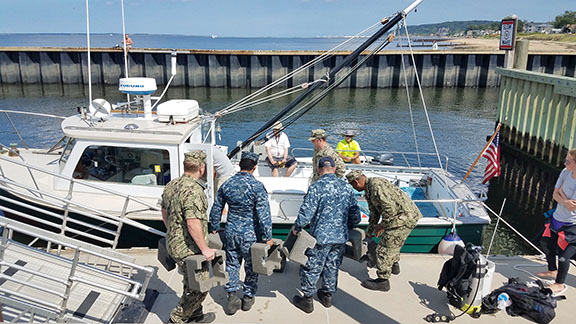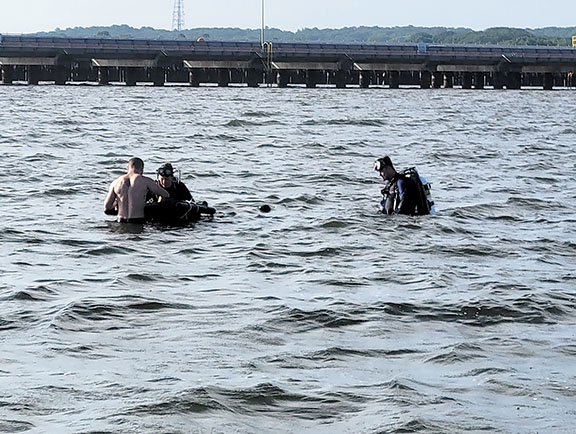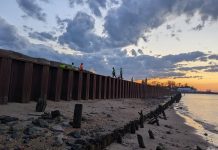
Courtesy NY/NJ Baykeeper
By Chris Rotolo
MIDDLETOWN – Tucked behind the protected walls and policed piers of Naval Weapons Station Earle, a guardian of the local waterways is working to safeguard and fortify the Bayshore’s coastal communities through natural ecological restoration.
Once a thriving habitat for oyster reef growth, the Hudson-Raritan estuary, including its coastal Sandy Hook Bay waters, has been nearly wiped clean of these natural habitats due to extended periods of water pollution, overharvesting and neglect.
The recent award of a $220,000 grant to NY/NJ Baykeeper from the New Jersey Department of Environmental Protection will help sustain an ongoing living shoreline program, an effort to develop a refuge for local marine life to thrive and reproduce, while defending the coastlines from harmful erosion.
“This funding will allow us to expand our capacity and partnerships with the DEP, Monmouth University, Rutgers (University) and our consultant to build upon the work we’ve already done, and refine our approach through targeted, data-driven decisions,” Meredith Comi, Coastal Restoration Program director for NY/NJ Baykeeper told The Two River Times.

Comi and her team were welcomed into the waters of Naval Weapons Station Earle in 2012. Her team was provided a permit to test and conduct research in 10 acres of bay bottom between the base’s secured trestles, which are visible from the beachfront of Bayshore Waterfront Park, and smaller plots of sand to the south in Atlantic Highlands.
Since establishing itself at the base, Comi’s team has experimented with the construction and placement of various underwater habitats aimed at igniting oyster growth and creating a safe environment for other marine life, such as crabs, worms, shrimp, sea urchins and local species of fish.
Comi said the most successful structures are referred to as “castles,” 12-by-12-inch concrete blocks “that fit together like LEGO pieces” to create a pyramid. The castles are placed in a controlled environment – outdoor aquaculture tanks – and set with oyster larvae, which begins to settle and grow within approximately 24 hours. For the next month, the oysters are served algae and monitored, before the pyramids are repositioned amongst the living shoreline.
“Once the oysters set on the castles, the next step is to see how the structures hold up in natural environments, as well as to monitor the mortality rate, growth and density of the oysters and other critters that had been attracted to the site,” Comi explained. “We also set up and observe sediment traps to see how much sediment is building up around the castles and staying behind to build up our coastlines.”
With years’ worth of data to guide the transition into Phase 2, future work will include deeper examination of current living shoreline infrastructure and the testing of additional structures.
According to Comi, her team has been testing preliminary designs of more nature-based installations across 3,200 linear feet of naval base coastline. The new grant funding will support bringing these structures to the final design stage and through the permitting process.
“Now that we’ve seen some success with the castles, we can begin refining that. Based on the energy and movement of bay waters, maybe we can orient the castles differently and see even better results. We can also start to answer the question ‘What else can we put out there?’ ” Comi said.
As well as the positioning of fish huts and the introduction of grass and other plant life, Comi said one venture in particular has proven particularly fruitful.
Last summer she and her team partnered with members of the Central Regional High School ice hockey program to repurpose broken hockey sticks into reefs. Though they were not set with oyster larvae, these artificial reefs were placed at sites in Carney Point, Liberty State Park and in the Bayshore waters of Keyport.
“We set these installations with the purpose of seeing if they were strong enough to stay together in coastal waters. We weren’t sure they would hold up, but we’re happy to report that they have,” Comi said. “They’ve currently been moved into our oyster setting tanks before we transition them into our testing area” at Naval Weapons Station Earle.
Comi said her team and the Central Regional program had another build session in the middle of July and were able to create 11 more units that will undergo a similar testing process.
The article originally appeared in the August 4 – 10, 2022 print edition of The Two River Times.















